Picking the perfect meal for your Labrador is more than just filling up a bowl—it’s like an art that can really affect your furry buddy’s health, happiness, and how long they live.
In 2024, canine nutrition has come a long way, with all kinds of options that cater to your Lab’s specific needs.
But with so many choices, how do you know what’s good and what’s not?
From high-protein formulas that give them all the energy they need to special kibbles that keep their joints healthy, we’re about to go on a food adventure that’s made just for your precious Labrador.
Ready to find out the secret ingredients to a happier, healthier Lab? Let’s jump right in and discover the best food options that’ll make your Labrador wag their tail with joy!
High-Calorie Diet Requirements

Your Labrador’s high-calorie diet needs to be packed with quality ingredients to keep them healthy and energetic.
It’s important to make certain that high-quality protein sources, such as chicken or fish, are the first ingredient in their food, as this provides the necessary building blocks for muscle maintenance and overall health.
You’ll want to focus on omega-3 fatty acids, complex carbohydrates, and vital nutrients for bone health. By balancing these elements, you’re setting your furry friend up for a tail-wagging good time and peak health.
Additionally, consulting with a veterinarian can help tailor the diet to meet their specific nutritional needs, particularly in light of their specific dietary requirements.
High-Quality Protein Sources
Labradors need a protein-packed diet to keep their tails wagging and bodies strong.
When it comes to high-protein dog food for your Lab, you’ll want to aim for 20% to 30% protein content.
This might sound like a lot, but it’s vital for maintaining their muscles and overall health. Focusing on high-quality protein sources will guarantee that your dog receives the necessary nutrients to thrive, including essential amino acids for muscle development and repair.
You’ll want to focus on quality protein sources for your furry friend. Chicken, beef, and fish are excellent options that provide all the necessary amino acids.
These building blocks are essential for your Lab’s strong bones and joints.
Remember, active Labradors especially need this high-protein diet to keep up with their energy levels and support muscle development.
Vet’s Tip: Our top picks for Labradors include high-quality protein sources like real chicken, beef, or fish as the first ingredient.
Look for dog foods with a protein content between 20% to 30% to support your Lab’s active lifestyle.
Choosing dog food with real meat or meat meals as the main ingredients can help reduce the risk of hip dysplasia, a common concern for large breeds like Labs. Don’t forget to include some healthy fats alongside the protein.
Omega-3 Fatty Acids

Every Labrador needs a healthy dose of omega-3 fatty acids in their diet. These essential nutrients play a vital role in keeping your furry friend happy and healthy.
You’ll find omega-3s in ingredients like fish oil and flaxseed, which are great for maintaining your Lab’s skin and coat.
They help reduce the risk of allergies and keep that beautiful fur shiny and smooth. Including omega-3s can also contribute to a balanced diet, as they support overall health, joint function, and cognitive abilities, which are necessary for active dogs like Labradors.
Vet’s Tip: Aim for a diet that provides about 30mg of EPA and DHA (types of omega-3) per pound of body weight daily for optimal health benefits in Labradors.
But that’s not all! Omega-3 fatty acids are also fantastic for your Lab’s brain health.
They support cognitive function, which is especially important for active and aging dogs. Your smart pup might even become a bit sharper with these brain-boosting nutrients.
One of the best benefits of omega-3s is their ability to reduce inflammation. This is super important for Labradors, who can be prone to joint issues.
Our Nutritionists Say: When choosing omega-3 supplements for your Labrador, look for those derived from marine sources like fish oil, as they are more easily absorbed than plant-based alternatives.
Complex Carbs for Energy
Complex carbohydrates are the powerhouse fuel for your energetic Labrador. These healthy carbohydrates are essential for keeping your furry friend active and playful throughout the day.
Your Lab needs about 30-40% of their daily calories to come from complex carbs to support their high-energy lifestyle.
When choosing food for your Labrador, look for options that include brown rice, oatmeal, or sweet potatoes.
These ingredients provide the sustained energy your pup needs for long walks, fetch sessions, and playtime at the park.
Complex carbohydrates also help maintain your Lab’s ideal body weight, reducing the risk of obesity while still meeting their energy requirements.
Essential Nutrients for Bone Health

Now that we’ve covered energy sources, let’s talk about keeping your Lab’s bones strong and healthy.
Your Labrador Retriever needs a high-calorie diet to support their active lifestyle, and that includes plenty of nutrients for bone health.
Calcium and phosphorus are super important for your furry friend’s bones, especially when they’re growing puppies.
Vet’s Tip: Aim for a diet with 20-30% protein to maintain your Lab’s muscle mass and overall health.
Include 8-15% healthy fats to help absorb vitamins and keep their skin in excellent condition.
You might be wondering, “How do I make sure my Lab gets all these nutrients?“
Good news! Many high-quality commercial dog foods designed for large breeds already have the right balance of vitamins and minerals.
Hip Dysplasia Risks
As a Labrador owner, you need to be aware of hip dysplasia risks and how diet plays an essential role in prevention.
Your Lab’s weight management is key to reducing strain on their joints and lowering the chances of developing this painful condition.
Understanding the beneficial nutrients that support joint health can help you make informed decisions about your furry friend’s meals and keep them happy and healthy for years to come.
Diet’s Role in Prevention
When it comes to preventing hip dysplasia in Labradors, diet plays an essential role. You’ll want to focus on providing your furry friend with the right balance of nutrients, especially during their puppy stage.
While some pet owners might consider grain-free dog food, it’s more important to guarantee your Lab’s diet has the correct calcium and protein levels to support healthy bone growth.
For large breed puppies like Labradors, controlling calcium intake is vital. Too much calcium can lead to developmental orthopedic diseases, including hip dysplasia.
As your Lab grows into adulthood, a diet with high protein content (around 20-30%) helps maintain strong muscles and supports joint health.
Vet’s Tip: Consult with your veterinarian about the appropriate calcium-to-phosphorus ratio in your Labrador’s diet.
A ratio of 1.2:1 to 1.4:1 is generally recommended for large breed puppies to promote healthy bone development.
It’s important to shift your Lab to an adult formula at the right time, typically between 15-24 months old.
This gradual change helps reduce risks associated with early dietary shifts that could worsen hip problems. Remember, maintaining a healthy weight through proper portion control and high-quality nutrition can greatly lower the risk of hip dysplasia.
In fact, keeping your Lab at an ideal body condition can add nearly two years to their lifespan!
Best Dog Food for Labradors: Our Picks
A Labrador’s ideal diet should be rich in high-quality proteins, essential fatty acids, and vital vitamins and minerals.
These elements support their active lifestyle, maintain their lustrous coat, and promote overall health. Whether you’re looking for premium options or budget-friendly choices, our comprehensive guide will help you find the perfect food for your beloved Labrador.
Read on to discover our top 10 recommendations that cater to various preferences and nutritional requirements.
Royal Canin Labrador Retriever Adult Dry Dog Food
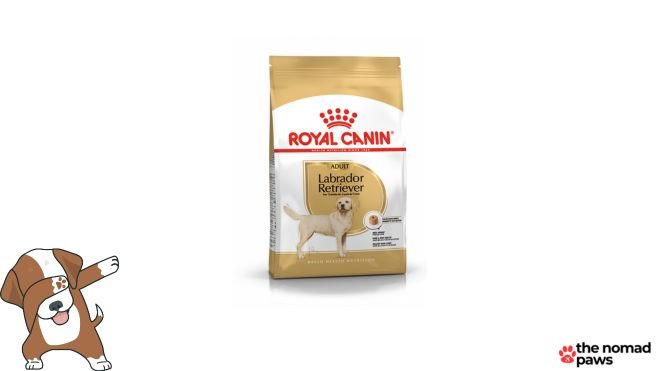
Specially formulated for Labradors, this kibble supports joint health and weight management. Its unique shape encourages slower eating, reducing the risk of bloat in this food-loving breed.
Purina Pro Plan Large Breed Adult Chicken & Rice Formula
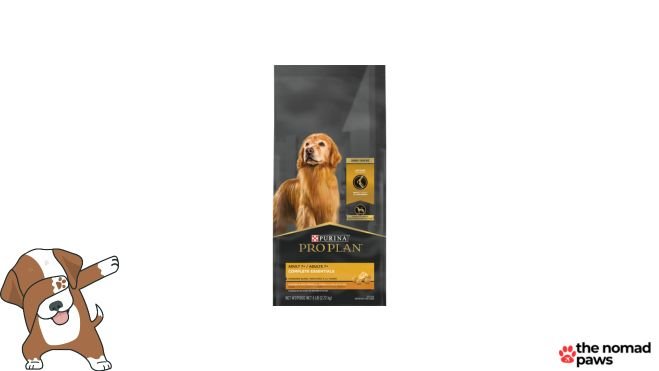
High in protein and fortified with glucosamine, this option promotes lean muscle mass and supports your Lab’s active joints. The added probiotics boost digestive health, ensuring optimal nutrient absorption.
Hill’s Science Diet Adult Large Breed Chicken & Barley Recipe
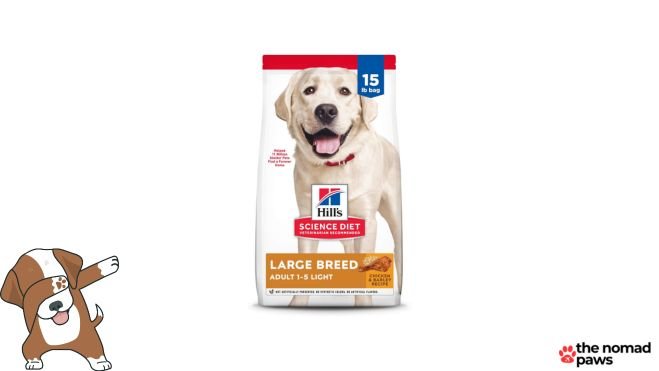
Packed with natural sources of glucosamine and chondroitin, this formula aids in maintaining your Lab’s healthy joints. The balanced nutrition supports a strong immune system and promotes a healthy coat.
Blue Buffalo Life Protection Formula Large Breed Adult
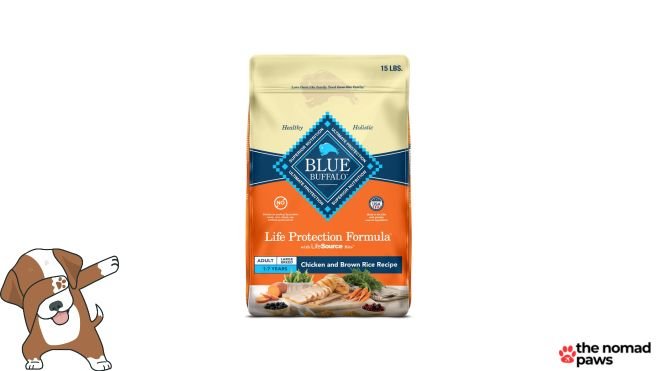
Featuring real deboned chicken as the first ingredient, this food provides high-quality protein for your Lab. The addition of LifeSource Bits delivers a precise blend of antioxidants, vitamins, and minerals.
Wellness CORE Large Breed Grain-Free Adult
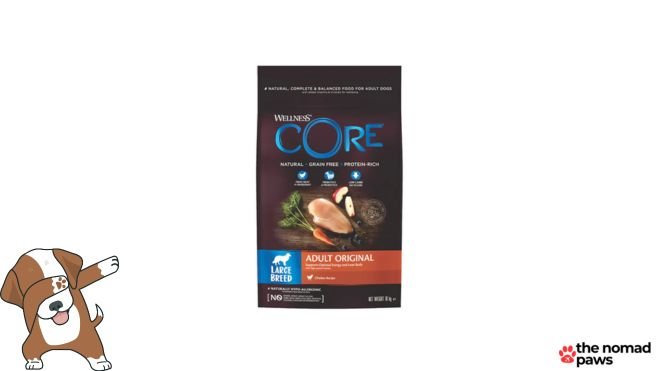
For Labs with grain sensitivities, this protein-rich, grain-free option supports lean body mass and overall health. The added taurine promotes heart health in large breeds like Labradors.
Nutro Ultra Large Breed Adult Dry Dog Food

A trio of proteins – chicken, lamb, and salmon – provides a diverse amino acid profile. The blend of superfoods offers a wide range of nutrients to support your Lab’s overall well-being.
Eukanuba Adult Dry Dog Food Chicken – Large Breed
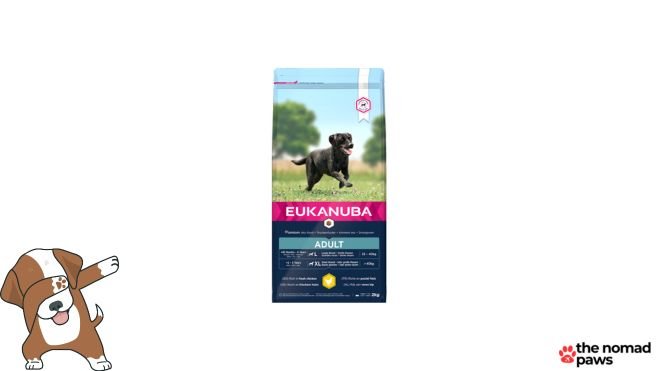
Formulated with animal-based proteins and optimal levels of fats, this food fuels your Lab’s active lifestyle. The 3D DentaDefense System helps reduce tartar buildup, promoting dental health.
Iams ProActive Health Adult Large Breed
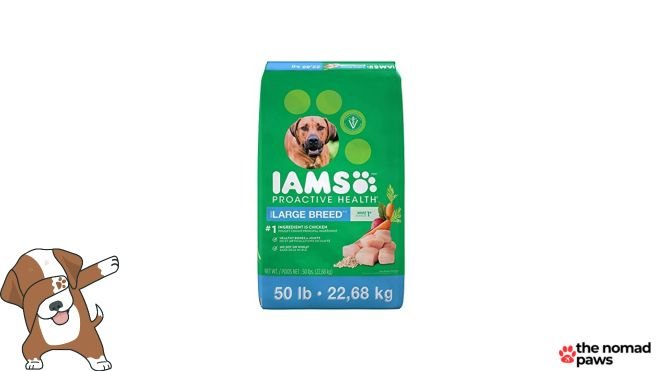
An affordable option that doesn’t skimp on quality, this formula includes farm-raised chicken and wholesome grains. L-carnitine aids in maintaining a healthy weight, crucial for joint health in Labradors.
Taste of the Wild Pacific Stream Grain-Free Dry Dog Food
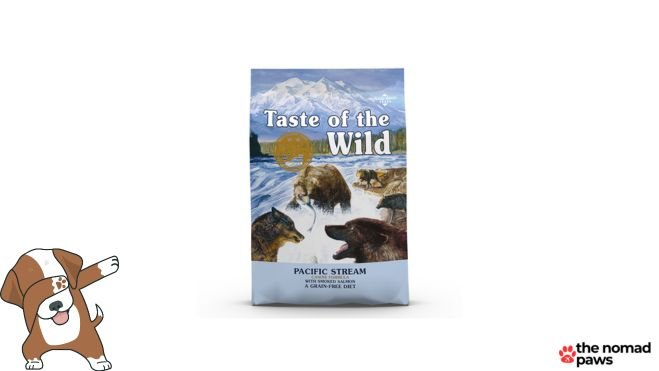
Featuring novel proteins like salmon and ocean fish meal, this option is excellent for Labs with food sensitivities. The grain-free formula includes superfoods for added nutritional support.
Merrick Classic Healthy Grains Large Breed Recipe
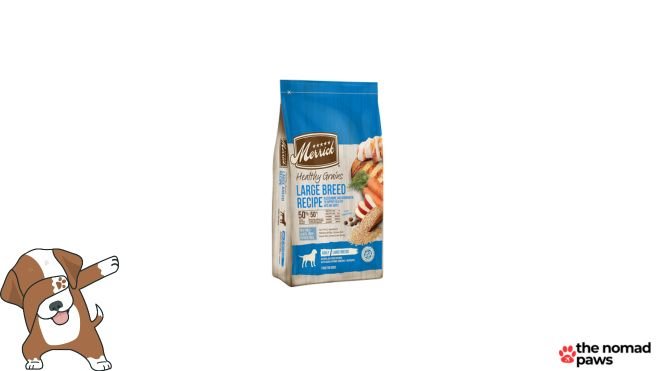
Deboned chicken leads the ingredient list, providing quality protein for your Lab. The inclusion of healthy grains like brown rice and barley offers sustained energy for this active breed.
Top Protein Sources
For your Labrador’s protein needs, several top-quality dog foods stand out. These options provide the essential amino acids your furry friend requires for muscle maintenance and overall health.
Let’s explore some of the best choices available.
Purina Pro Plan’s High Protein Shredded Blend is an excellent option, containing 25% protein.
This formula is perfect for active Labradors, helping them maintain their energy levels throughout the day. If you’re looking for something with even more protein, Wellness Core Large Breed Adult might be the answer.
With 38% protein content, it’s specifically designed for large breeds like Labradors, promoting lean muscle mass and supporting joint health.
Vet’s Tip: When choosing a high-protein dog food for your Labrador, always consult with your veterinarian first. They can help determine the ideal protein content based on your dog’s age, activity level, and overall health.
For the ideal protein punch, consider Orijen Original. This impressive formula boasts 43% protein, using fresh, high-quality animal ingredients to support your Lab’s best health and energy.
Another great choice is Blue Buffalo Life Protection Formula, which includes protein-rich ingredients like deboned chicken. This balanced nutrition is ideal for your Labrador’s active lifestyle.
Remember, high-quality protein sources such as chicken, beef, and fish are vital for your Lab’s well-being, so choose wisely!
Dry Vs. Wet Food
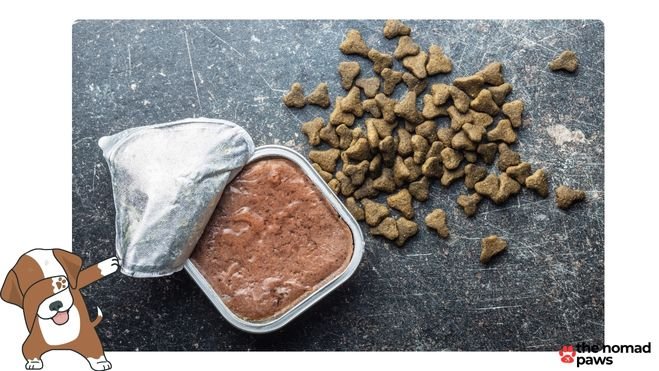
When it comes to choosing between dry and wet food for your Labrador, there’s no one-size-fits-all answer.
Both options have their pros and cons, and the best choice depends on your dog’s needs and your lifestyle.
Dry food is often more budget-friendly and has a longer shelf life, making it convenient for many Labrador owners. It’s also great for dental health, as the crunchy kibble can help clean your dog’s teeth.
Many high-quality dry foods, like Royal Canin Labrador Retriever Adult and Purina Pro Plan, are specially made to meet your Lab’s nutritional needs.
On the other hand, wet food can be a real treat for your furry friend. It has more moisture, which helps keep your Lab hydrated and can be easier to eat, especially for older dogs or those with dental issues.
Wet food is often more appetizing, too, which can be a big help if you’ve got a picky eater on your hands.
Can’t decide? You don’t have to! Many Lab owners find that a mix of both dry and wet food works best, giving their dogs the benefits of both options.
Vet’s Tip: consider combining wet and dry food to provide a balanced diet. Mix a small amount of wet food with your Lab’s regular kibble to increase palatability and moisture intake while maintaining dental benefits.
Grain-Free Options
Grain-free dog food has become a popular option for many Labrador owners, especially those with pups who have sensitive tummies or food allergies. If you’re considering a grain-free diet for your Lab, there are several high-quality options available.
One excellent choice is Taste of the Wild (High Prairie), which uses water buffalo and lamb meal as its main protein sources.
This Grain-Free Dry Dog Food is packed with vital nutrients and is gluten-free, making it a great option for Labs with sensitivities.
Another top pick is Wellness Core Large Breed, specifically designed for bigger dogs like Labradors. With 38% protein content, it supports healthy muscle mass and joint health.
Vet’s Tip: While grain-free diets can be beneficial for some dogs, it’s crucial to consult with your veterinarian before making any significant changes to your Lab’s diet.
Not all dogs require a grain-free diet, and some may even benefit from grains in their food.
For Labs who need an extra protein boost, Orijen Original is a fantastic grain-free option. It contains 85% high-quality animal protein, promoting overall health and energy levels.
While grain-free diets can be beneficial, it’s important to choose a food that meets AAFCO nutrient profiles for your Lab’s specific needs.
Always consult with your vet before making significant changes to your dog’s diet to guarantee you’re providing the best nutrition for your furry friend.
Grain-Free Controversy: the FDA Investigation
You might’ve heard about the grain-free diet controversy and its potential link to heart problems in dogs.
This issue has caused quite a stir among pet owners, especially those with Labradors who may be more prone to heart issues.
While grain-free diets were initially praised for reducing food allergies, recent concerns about nutrient imbalances and the FDA’s alert about possible taurine deficiency have led many to reconsider their food choices for their furry friends.
Uncooked, Nutrient-Dense BARF Diet
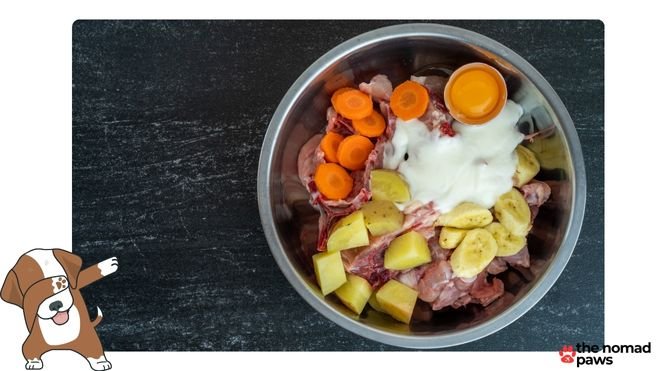
Many Lab owners are turning to the BARF diet, which stands for Biologically Appropriate Raw Food.
This high protein diet aims to mimic what your Lab’s wild ancestors would have eaten. It typically consists of 70-80% raw meat, 10-20% vegetables, and 5-10% supplements to guarantee balanced nutrition.
The BARF diet for Labs often includes raw chicken, beef, and organ meats, along with raw bones for calcium and vital fatty acids.
This nutrient-dense approach can lead to improved coat quality and higher energy levels in your furry friend. It’s free from fillers and provides easily digestible nutrients tailored for active breeds like Labs.
Vet’s Tip: Always consult with a veterinarian or canine nutritionist before switching to a BARF diet. They can help ensure the diet meets your Lab’s specific nutritional needs and health considerations.
If you’re considering switching to a BARF diet, it’s important to shift slowly. Mix small amounts of raw food with your Lab’s current diet over 7-10 days to prevent tummy troubles.
Age-Specific Formulas
Just like humans, Labradors have different nutritional needs at various life stages. That’s why age-specific formulas are so important for your furry friend’s health and happiness.
For Labrador puppies, you’ll want to choose a food that’s high in protein but lower in calcium. This helps prevent developmental issues like hip dysplasia. Keep your pup on puppy food until they’re 15-24 months old. It’s vital for their growth!
Adult Labradors need a balanced diet with about 20-30% protein to keep their muscles strong and support their active lifestyle. Look for high-quality ingredients and avoid fillers.
As your Lab enters their senior years, they’ll benefit from a diet that’s lower in calories but still packed with nutrients. Foods with added joint support ingredients like glucosamine can help with age-related health concerns.
Brands like Royal Canin and Hills Science Diet offer Labrador-specific formulas for different life stages. When switching between age-specific formulas, do it gradually over 1-2 weeks to avoid tummy troubles.
Weight Management Choices
When it comes to weight management, you’ve got some great options for the best dog foods.
Purina Pro Plan Adult Large Breed is a fantastic high-protein option. It’s well-rated and reasonably priced, making it a solid choice for your Lab’s weight management needs.
If you’re looking for a breed-specific formula, Royal Canin Labrador Retriever Adult is tailored just for Labs. It’s pricier but highly rated for its weight control benefits.
Hill’s Science Diet Adult Large Breed offers a balanced diet that’s great for maintaining a healthy weight.
Another excellent option is Purina Pro Plan High Protein Shredded Blend, which provides the protein your Lab needs while supporting weight management.
Finally, if you prefer a food free from corn, wheat, and soy, Blue Buffalo Life Protection Formula is a great choice. It’s well-rated and competitively priced, making it an attractive option for conscientious dog parents.
Allergy-Friendly Ingredients
Allergies can be a real pain for our furry friends, especially Labradors.
If your Lab is struggling with food sensitivities, don’t worry! There are plenty of allergy-friendly options available to keep your pup healthy and happy.
Vet’s Tip: Always consult with your veterinarian before making significant changes to your dog’s diet, especially if they have known allergies or sensitivities.
When choosing food for your allergic Labrador, look for formulas that avoid common allergens like corn, wheat, and soy.
Blue Buffalo’s Life Protection Formula is a great choice, as it’s free from these ingredients.
If your Lab is sensitive to grains, Taste of the Wild High Prairie offers a grain-free recipe with high-protein sources like water buffalo and lamb meal.
For dogs with particularly sensitive stomachs, Purina Pro Plan Sensitive Skin & Stomach uses salmon as the main protein source to minimize allergic reactions.
Hills Science Diet Sensitive Stomach & Skin includes easily digestible ingredients like chicken and yellow peas, perfect for Labs prone to tummy troubles.
Don’t forget about breed-specific options! Royal Canin Labrador Retriever Adult is tailored for Labs, providing balanced nutrition while consid
Homemade Dog Food
Making homemade dog food can be a great way to control what goes into your pup’s diet, but it’s important to do it right.
Always consult with your veterinarian before starting a homemade diet for your Labrador. They can help you create a balanced meal plan tailored to your dog’s specific needs and health condition.
When creating a balanced diet for your Labrador, focus on high-quality protein sources like chicken, beef, or fish. These provide essential amino acids for your dog’s health.
Don’t forget to include healthy fats, such as fish oil or flaxseed oil, which help with vitamin absorption and keep your Lab’s coat shiny.
How Much Should a Labrador Eat?
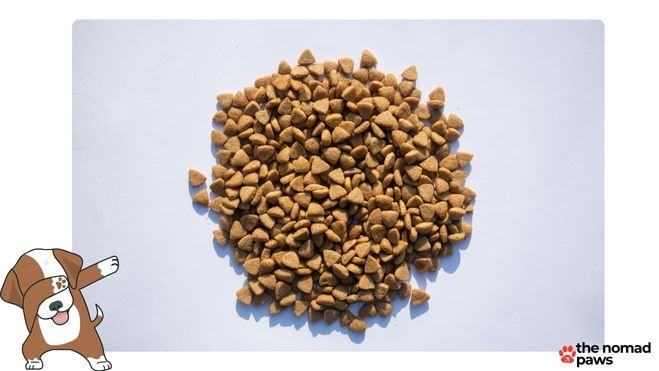
You’ll want to keep a close eye on your Labrador’s meals to prevent obesity, which is a common issue for this breed.
As your Lab grows from a puppy to an adult, you’ll need to adjust their feeding schedule and portion sizes accordingly.
Remember, your Lab’s activity level plays a big role in determining how much food they need, so be prepared to make adjustments based on their lifestyle and age.
Frequent Small Meals for Puppies
Feeding your Labrador puppy might seem like a full-time job, but it’s essential for their health and development.
For Labrador puppies, frequent small meals are the way to go.
You’ll want to serve your pup three to four smaller meals a day until they’re about six months old.
This feeding schedule helps regulate their energy levels and prevents overeating, which can lead to obesity – a common concern for Labs.
Monitor portion sizes carefully. Divide your puppy’s total daily food intake into measured meals to avoid excessive calorie consumption.
Be cautious with treats and table scraps for your Labrador puppy. These extras can quickly add up in calories and contribute to weight gain.
Limit treats to no more than 10% of your puppy’s daily caloric intake to maintain a healthy weight and proper nutrition
Twice-Daily Measured Portions
As your Labrador grows into adulthood, it’s time to shift from frequent puppy meals to a more structured feeding routine.
Twice-daily measured portions are the way to go for your grown-up furry friend. This feeding method is essential for maintaining your Lab’s healthy weight and preventing obesity, which is a common issue in this breed.
Adjust Portions for Aging Metabolism
As your Labrador gets older, you’ll need to pay close attention to their diet, especially when it comes to portion sizes.
Aging Labradors experience a slowdown in their metabolism, which means they don’t burn calories as quickly as they used to. This change can lead to weight gain if you’re not careful.
To keep your senior Lab healthy, you’ll want to adjust their food portions.
Consider reducing their meals by 10-20% to match their decreased activity levels. It’s vital to maintain a healthy weight for your aging Labrador, as excess pounds can increase the risk of health issues like hip dysplasia.
Regular weigh-ins and vet check-ups will help you stay on top of any necessary adjustments.
Slow Food Switchover Method
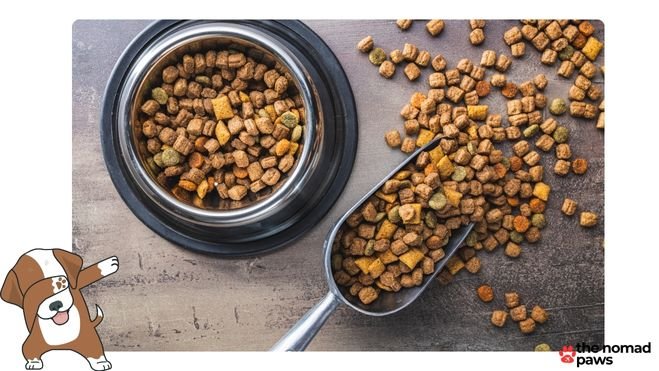
When you’re ready to switch your Labrador to a new food, it’s important to do it gradually over seven days.
Start by mixing a small amount of the new food with their current food, and slowly increase the proportion of new food each day.
Keep a close eye on your Lab’s stools during this changeover, as loose stools can be a sign that you’re moving too quickly or that the new food isn’t agreeing with your pup.
Seven-Day Food Transition Schedule
Switching your Labrador’s food can be tricky, but don’t worry! A seven-day food change schedule is your best friend when it comes to keeping your pup’s tummy happy.
This gradual approach helps prevent digestive upset and makes the change easier for your furry friend.
Let’s break it down day by day.
- On days 1 and 2, start by mixing 25% of the new food with 75% of the old food. This gentle introduction lets your Lab’s system adjust slowly.
- As you move to days 3 and 4, it’s time to go half and half – 50% new food and 50% old food. Your dog’s getting used to the new taste and texture now!
- For days 5 and 6, increase the new food to 75% and reduce the old food to 25%. You’re almost there! Finally, on day 7, your Lab should be ready for 100% new food. Throughout this process, keep a close eye on your pup. If you notice any tummy troubles or changes in behavior, don’t hesitate to slow down the change or consult your vet.
Watch for Loose Stools
Tummy troubles can be a real pain for your Lab during a food switch. That’s why it’s essential to keep an eye out for loose stools, which can signal that the shift isn’t going smoothly.
When you’re changing your Labrador’s food, remember that their digestive system needs time to adjust.
If you notice runny poop, it might mean you’re moving too fast or that the new food doesn’t agree with your furry friend.
Don’t panic if you see some loose stools.
It’s not uncommon during a diet change. However, if it continues for more than a couple of days, it’s time to slow down the shift process.
Stick with the current mix of old and new food until your Lab’s poop firms up. This might mean staying at the same ratio for an extra day or two before increasing the new food amount.
If the loose stools persist or your Lab seems uncomfortable, it’s best to consult your vet. They can help determine if there’s an underlying issue or if a different food might be a better fit for your pup’s tummy.





